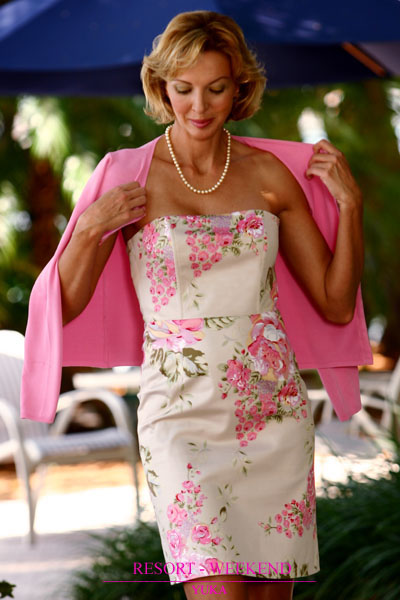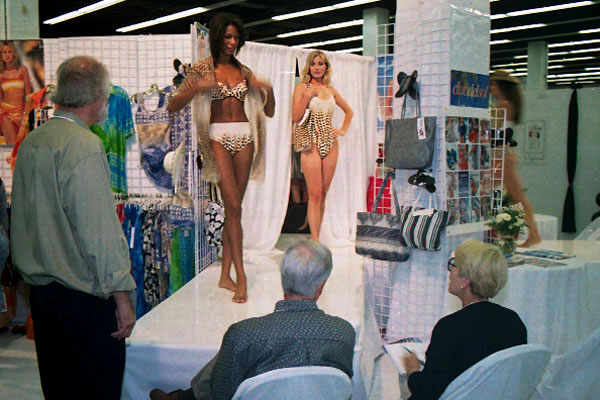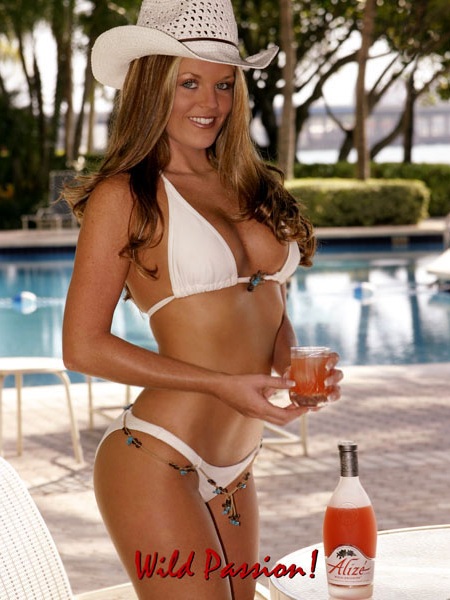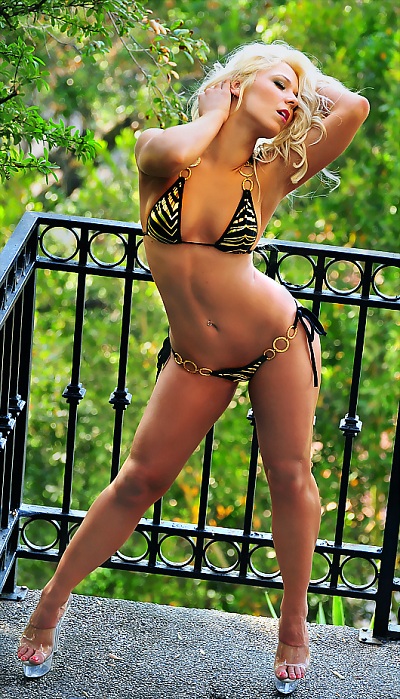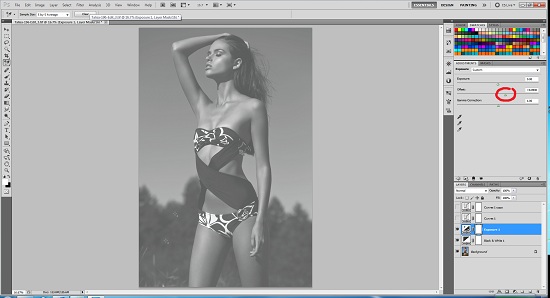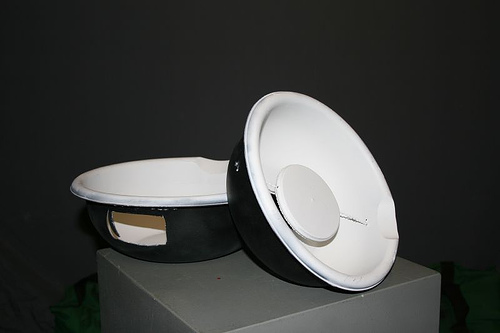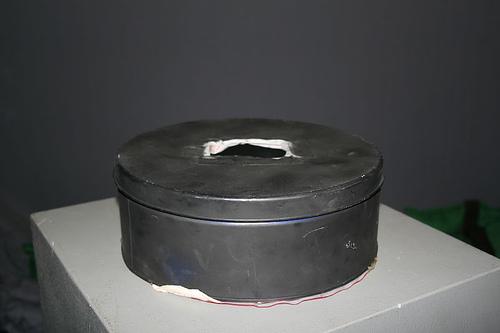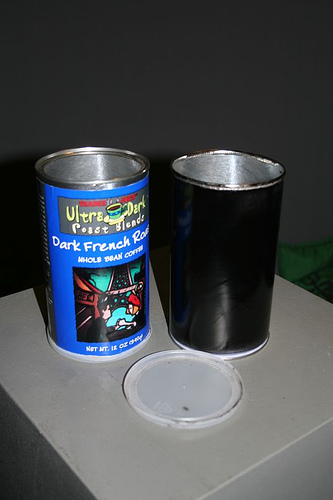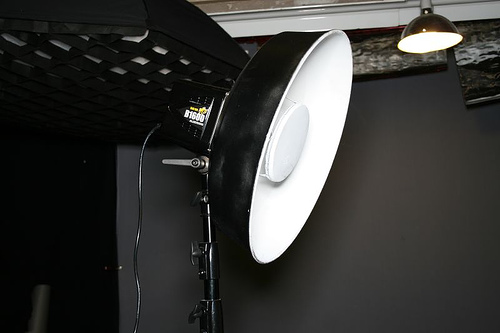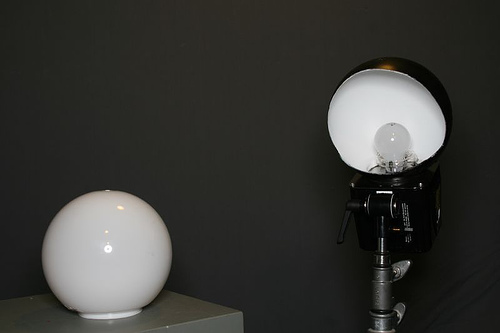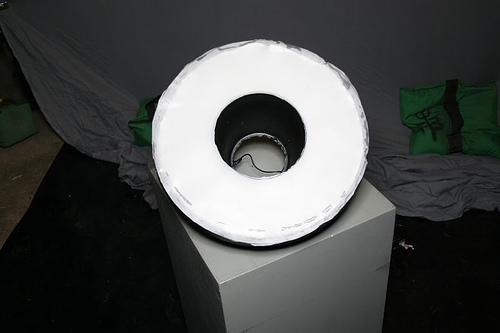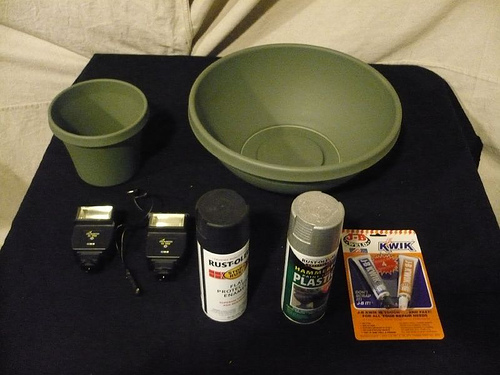Do you feel that your current camera has been limiting your
creative talent? If you have been using a point-and-shoot to capture all
of your artistic observations, but don’t quite feel sure about taking
the next big step into the dSLR (Digital Single Lens Reflex) world, then
Canon’s newest entry-level dSLR might be just what you’re looking for.
The EOS Rebel T3 is a great unit to get you started on a higher level of
photography. The T3 is the accolade of 2008′s
EOS Rebel XS,
with all the fantastic features of the latter, plus with a string of
new highlights. Atop of an 12.2-Megapixel CMOS image sensor, improved
control layout, DIGIC 4 processor, Live View shooting mode, 63-zone
Dual-layering metering system, and 1280×720 video mode; Canon
supplements the T3 with a new Creative Auto shooting mode, a hands-on
guide offering detailed descriptions of settings, a 2.7-inch LCD, EF and
EF-S lens mount, and more. With all of these great features, Canon’s
new entry-level EOS Rebel T3 looks to be a great choice for a first
dSLR.

Presumably, the first characteristic you will notice about the T3 is
its compact size. Pretty much the exact size of its brother, the
EOS Rebel T3i,
the T3 is approx. 5.1″ in width, 3.9″ in height, and 3.1″ in diameter.
However, immediately you will notice that the T3 lacks the texturized
grips of the T3i, which some may consider a negative. While we do enjoy
the non-slip grips, the ergonomically shaped grip maintains a sufficient
hold. Atop of the shooting hand grip is a natural-placed shutter
release and a grooved control dial for fine-tuning the camera’s
settings. Opposite, the left side of the camera houses the I/O ports
that include a remote release, a USB/A/V, and a HDMI port; all of which
is enclosed under a rubber cover.
Moving along the T3′s top are the retractable flash and the hot shoe
(mount for flash accessory). The pop-up flash is automatic, or has a
dedicated button next to the mode dial. Approximately the size of a
nickel, the mode dial rests on the shooting hand side of the T3. The
serrated edges and distinctive “clicks” between each setting, make using
the mode dial a breeze. Like its predecessors, the T3 mode dial
includes basic and advanced shooting modes, along with an automatic
mode. A straightforward “on/off” power switch is right alongside the
mode dial, which as simple as it sounds, is a definite plus. On the
back, the control layout is well-spaced and well-labeled. The buttons
and labels are fairly large and shaped according to design and function.
The T3 is meant to be a first dSLR for the novice photographer, and if
you are slightly overwhelmed at first by the “extra” buttons, don’t
fret; with logical labeling and an on-screen guide, you will understand
each button’s function quickly. The 4-way directional pad doubles as a
direct adjustment for white balance, burst shooting, ISO, and auto
focus.
Whether you’re a novice or an experienced photographer, the T3′s
control layout is comprehensible. Additionally, if you are familiar with
Canon’s earlier XS model, you will have no problem with the T3. The
Menu and Disp. Buttons have a new, well-received location on the right
side of the camera. This now allows for all the button manipulation to
be accessible with just one hand. Not only are the buttons more
thoughtfully placed on the T3, but they are larger than those on the XS
as well; and this was accomplished without seeming cramped either.

Experts know, and novices will discover that one of the advantages of
a dSLR is the Optical ViewFinder (OVF); and the T3 is no exception.
Like the T3i, it uses a pentamirror OVF (as opposed to pentaprizm). The
T3 OVF is somewhat less equipped than its superior brother. While the
eye-level unit still offers a large and clear view of your subject, it
is noted on Canon’s website that the T3 has approximately a 0.8x
magnification; whereas the T3i is equipped with a 0.85x magnification.
This slight deviation makes for a smaller picture in the OVF. If you
have poor eyesight, it is important to note also that the T3 has a
diopter adjustment from a -2.5 to + 0.5, whereas the T3i has a wider
range of -3.0 to +1.0. Because of the lesser range of the T3′s diopter
adjustments, it may be difficult for someone with weak vision to achieve
a clear focus without glasses. However, where the T3 improves is on the
eye relief from the OVF, or eyepoint. The eyepoint on the T3 moves out
to 21mm (19mm on the T3i), which means you can hold your eye further
away from the OVF and still see the whole frame. Although it is only a
difference of 2mm, this improvement could help you acquire your subject
more quickly. The Vertical/Horizontal still has coverage of about 95% of
the image capture, which gives you 5% leeway around the edges. It is
also worth mentioning that the rubber eye up is very comfortable, and
blocks out most of the ambient light when your face is pressed against
it. A good bit of exposure data is displayed in the Heads Up Display
(HUD), allowing you to assess exposure info without taking your eye away
from the viewfinder, and remain focused on your subject.

A nice feature carried directly from the XS to the T3 is the mode
dial. Offering 14 shooting modes, this handy characteristic permits
quick switching between shooting modes without having to go through the
menu. The auto shooting modes are centered: Full Auto, Flash Off, and
Creative Auto. Full Auto mode will automatically adjust the camera’s
shooting settings for an optimal image capture. The new Creative Auto
gives the user a little more control over exposure by granting an
ambiance adjustment (vivid, soft, warm, etc.). For more specific shots,
the mode dial contains 5 scene modes (portrait, landscape, close-up,
sports, and night portrait) which have fine-tuning adjustments for each.
If you are looking to get even more particular with a shot, the dial
also presents 5 more modes. A Program mode that automatically sets the
shutter speed and aperture, but other setting may be manually
configured. Shutter or Aperture Priority modes help capture moving
objects and backgrounds, while the Auto Depth-of-Field AE (A-DEP)
maintains a focused foreground and background. Finally, for complete
control, Manual mode gives the photographer total control over the image
capture.
A handy feature Canon has decided to include from the XS is its convenient quick control menu. According to
Canon’s website,
the quick control (shooting) menu is accessible by giving you “instant
access to the most common settings all in one place”. The menu is not
much different from that on the XS, other than an improved look and a
few additional adjustment options. An option to raise the built-in flash
is added (even though there is a dedicated button for this function
behind the control dial), as well as a flash level adjustment. An
automatic brightness/contrast adjustment is also included which allows
you to decide the level in which the camera will auto correct the
brightness and contrast of each image. In Manual mode, the shooting
settings menu will also give both aperture and shutter speed tweaking.
All of these modifications can be done by the combination of the AV or
“Q” button, the 4-way directional pad, and the control dial. It takes
some playing around and getting used to the camera’s control
manipulation, but you will quickly figure out a personal preference for
making alterations. On top of this, Canon does allow you to change the
operation of specific controls on the body, giving you a more tailored
fit. Both the SET and Flash buttons can be customized via the Custom
Functions menu.
Perhaps to keep the controls less cluttered, the Canon opted for a
2.7-inch LCD monitor instead of the 3.0-inch Vari-Angle monitor which is
on the T3i. Though smaller, the LCD is still a capable size to easily
view the menus, Live View, or picture/video playback. The pixel
specification is a 230,000 dot display, and although it offers a clear
view, it is significantly lower than that of the T3i; which boasts an
incredible 1,040,000 dots. The number of dots simply refers only to the
picture resolution of the LCD screen, not your images (therefore not
affecting image quality). Utilizing a protective cover to prevent damage
to the actual display, the screen does tend to collect fingerprints
rather easily. This was clearly evident in the bright sunlight, which
was compounded by a dim default backlight setting. Fortunately, the
backlight can be brightened, which I brightened to its highest setting.
The full display can be viewed up to 170°, but any further than that and
on-screen information will begin to be cut off. Lastly, it is
unfortunate that the T3 LCD does not have the Vari-Angle feature like
that of the T3i. This feature allowed the LCD to be tilted to a viewable
angle for those awkward low-to-the-ground or overhead shots. The lack
of a Vari-Angle LCD on the T3 is not a negative, but rather a luxury for
the T3i.
The T3 menu interface is congruent to Canon’s Rebel series. Utilizing
a logically organized, consistent, and easy to see and understand
color-coded layout, a novice to the Rebel line will rapidly be able to
efficiently navigate the camera. And, because the T3 employs a very
similar menu from past Rebel cameras, a user familiar with them will
feel right at home. Accomplished with either the control dial or the
4-way control, navigation through the menu interface is fast and simple.
Additionally pressing the display button while in the menu, the T3 will
bring you to the camera’s data such as memory, color space, screen
timeout, etc. Menu text is also very readable with a modern appearance
like you would typically find on a smartphone. Depending on which mode
setting the camera is in, the menu will offer more or less options, yet
maintaining a consistent order. Different menu categories (capture,
playback, camera settings) are nicely separated by colors for fast
identification and little confusion. Switching between modes via the
mode dial expels a brief menu displaying the current menu and a short
description of it. This element of the T3 is extremely handy, especially
for a beginner to dSLR cameras as it guides the user with the camera’s
full capabilities.
Like most all of Canon’s EOS Rebels, the T3 is a speedy performer.
From power-on until the first shot averaged at 2-3/10 of a second!
Waking the camera from Auto power off and capturing the first shot took
about 4-5/10 second. When pre-focusing the camera, shutter lag is almost
non-existent, measuring less than 1/10 second, while autofocus shutter
lag averaged just 1/10 second using the Auto Selection:9-point AF mode.
In single drive mode, the shot to shot varied depending on how I would
depress the shutter release. When lifting my finger each time the delay
averaged about 4-5/10 of a second between frames. However, by keeping
the shutter half-pressed and just pressing it in fully as fast as I
could, I was able to acquire shot to shot times of as fast as 3/10 of a
second between frames; like the T3i, the T3 is fast!. The T3 also boasts
burst shooting at up to 3fps at full resolution, which is about spot
on. When shooting a series of 10 frames in burst, I saw a frame rate of
about 3.2fps. When shooting a long string of 40 frames, the rate stayed
at approx. 3fps (2.96fps to be exact). Canon claims a Maximum Burst of
830 frames when shooting JPEG images, or up to 5 shots in RAW mode.
Obviously, the JPEG number requires you have the available space to
record that many photos on your SC/SDHC card; not to mention the time to
sit there for 830 shots. Putting the T3 into RAW mode did not effect
standard shooting performance by much, however Burst mode does see some
slowdown. On top of the max speed dropping down to about 2fps, that only
lasts for about 5 frames. While many like to use RAW mode, if you are
going to be shooting a string of burst images, we recommend you are in
JPEG mode. All of our tests were done using the kit EF-S 18-135mm
3.5-5.6 IS II zoom lens at wide angle, SanDisk Ultra II 4GB SDHC memory
card, Program mode, ISO Auto, ONE SHOT AF, Automatic point selection,
Evaluative metering, Preview on, with all other settings at default.
Times may vary depending on photographer response, lighting, camera
settings, media used, etc.
When it comes to shooting performance in Live View mode, Canon’s
models offer average results. Their Live View system has not really
changed much over the years, and that can been seen in its shooting
performance. While this may be a let down to some, we personally don’t
see too many people using Live View on this camera as their main framing
system. The OVF is a much better choice 95% of the time. We do however
feel that using Live View is a great option for static subject type
shooting, such as still life, macro, and product type photography, where
you generally are using a tripod and “shot to shot” times are not as
important. Entering LV mode takes about a second before the live image
displays on the LCD, and you are ready to frame a shot. Shutter lag was
about 1/10 of a second when pre-focused, however AF was as long a 3
seconds using the Live Mode AF setting, depending on several factors;
amount of focus change required, lighting, etc. The best time we
achieved with Live Mode AF was 1.6 seconds, which was at full wide angle
under some good overhead fluorescent lighting. Like we’ve seen with
past models, the camera will “hunt” for focus when in Live View mode,
especially when shooting indoors or in marginal lighting. Outdoors, the
AF is much faster (about 1 second), however it did still “hunt” quite
often.
In low light, like expected from a dSLR, the T3 performed great.
Using the OVF, the AF system acquired focus on the subject in less than ½
second with the pop-up flash employed for AF-assist, and almost a
second if the pop-up flash is not ready. The intelligent Full Auto mode
automatically deploys the flash in low light. In more advanced exposure
modes (Program, Manual, etc) the flash will not automatically deploy;
instead it must be manually activated if desired. Still, in these
exposure control modes, the autofocus acquired focus in less than ½
second. Compared side-by-side with the
Olympus E-P3,
an EVIL (Electronic Viewfinder Interchangeable Lens) camera, in low
light, the T3 was able to gain focus and snap a picture in a fraction of
the time it took the E-P3 to do so. This ability to quickly obtain
focus in low light is why many photogs opt for a dSLR over anything
else.
Image quality from the T3 lives up to our expectations for an
entry-level EOS dSLR. In most all situations, the T3 is able to capture
sharp photos that reproduce natural looking colors. Fine detail is
pleasing throughout the ISO range (even ISO 6400), and exposures are
pleasing. I did notice that when shooting under some harsh summer
sunlight, the T3 would tend to produce some strong exposures when using
the camera’s AE modes (Auto, Program, Av, Tv, etc.); which is to be
expected. However, it was able to retain good highlight details in these
exposures. This can be corrected quite easily with a bit of negative
exposure compensation, or by shooting in manual mode. Imager noise is
well controlled from ISO 100 all the way up to ISO 3200. The 6400
setting does show a good amount of both chroma and luminous noise when
viewing images at 25-100%, however you can still see a good amount of
fine detail. While you may not want to print off huge prints from images
captured using ISO 6400, I think they will be fine for normal sized
prints right out of the camera. Shooting in RAW mode, and working with
an image editor later will further enhance your ability to create
enlargements from photos taken using the higher ISO settings of this
camera.
After some practice, recording movies with the T3 is amusing. Filming
with a dSLR gives more control, but requires more effort than that of a
point-and-shoot. The T3 records HD movies in 720p at either 30 or 25
frames per second (adjusted in the movie menu). While 720p is fine for
most, it’s sad to see that the T3 does no offer the full 1080p HD
capabilities like that found on most all video equipped EOS dSLRs. While
it is recommended to manually focus while filming, the T3 can auto
focus as well. If you are using auto focus when shooting a movie, it is
important to enable the “AF w/ shutter button during [recording]” in the
movie menu, otherwise you would be up a creek without a paddle as far
as focusing is concerned. That being said, once recording has commenced,
half-pressing the shutter button will initiate the autofocus process. A
drawback with this method is that when you playback your video, the
focus motor can be heard. Consequentially, this is why manual focus is
recommended for recording videos. Most likely, after some practice, you
will discover how easily and quickly you will be able to zoom and focus
movies. This added control becomes quite enjoyable for the photographer
coming straight from a point-and-shoot camera. If filming with a
point-and-shoot is like driving an automatic vehicle, filming with a
dSLR would be like driving a manual transmission; more effort and
control, but a lot more fun after understanding the equipment and
operation.
Pros
- Lightweight and compact body available in four colors; Black, Red, Metallic Gray, and Brown
- Loads of useful exposure options for Any user
- Image quality is excellent, both indoors and out
- Flash button in comfortable location
- Button customization for various controls; like the flash and Set buttons for instance
- Robust shooting performance
- Capable AF system, even in low-light to almost total darkness with flash as AF-assist lamp
- OVF is nice and comfortable
- Impressive high ISO performance
- Amazing low price of just $599 US with the EF-S 18-55mm IS II kit lens
Cons
- No full HD video mode
- Exposure can be a bit strong at times when shooting in the automatic exposure modes in bright sunlight
- No rubberized grip like the T3i
- LCD is a bit small (2.7-inches), but usable
- Live View shooting performance is still quite sluggish
- Autofocus during Live View is very poor, hunting for focus both indoors and out
Timing test results
- Power up to first image captured = 2-3/10 of a second
- Shutter lag when prefocused = less than 1/10 of a second
- Shutter lag with autofocus = approx. 1/10 of a second, depending on lens used and amount of focus change required
- Shot to shot delay wo/flash = 4-5/10 of a second; as fast a 3/10 of a second at times
- Sequential or burst mode= 3fps @ 12M (we captured 40 Large/Fine JPEGs with no slow down)
- GUI Navigation = responsive
- All tests were taken using a Sandisk Ultra II 4GB SDHC memory card,
Program Mode, ISO Auto, Flash off, Review on, and all other settings at
the factory defaults unless noted otherwise.
Bottom line
Canon continues to produce powerful, yet affordable dSLRs for the
masses, and the Canon EOS Rebel T3 is no exception. If you are looking
for your first dSLR, the T3 is a worthy candidate that will offer you
superior performance and image quality compared to your point-n-shoot,
along with a broad range of exposure options that will help you further
your photography skills. With a MSRP of just $599.99 US for the EOS
Rebel T3 and EF-S 18-55mm IS II kit lens, the T3 is hard to beat in your
are looking for an extremely affordable dSLR. If you love the T3, but
would like a bit more versatility in both the still image and video
departments, we highly recommend you look at its big brother, the Canon EOS Rebel T3i.
Read the full review of the Canon EOS Rebel T3i on Steve’s Digicams.




